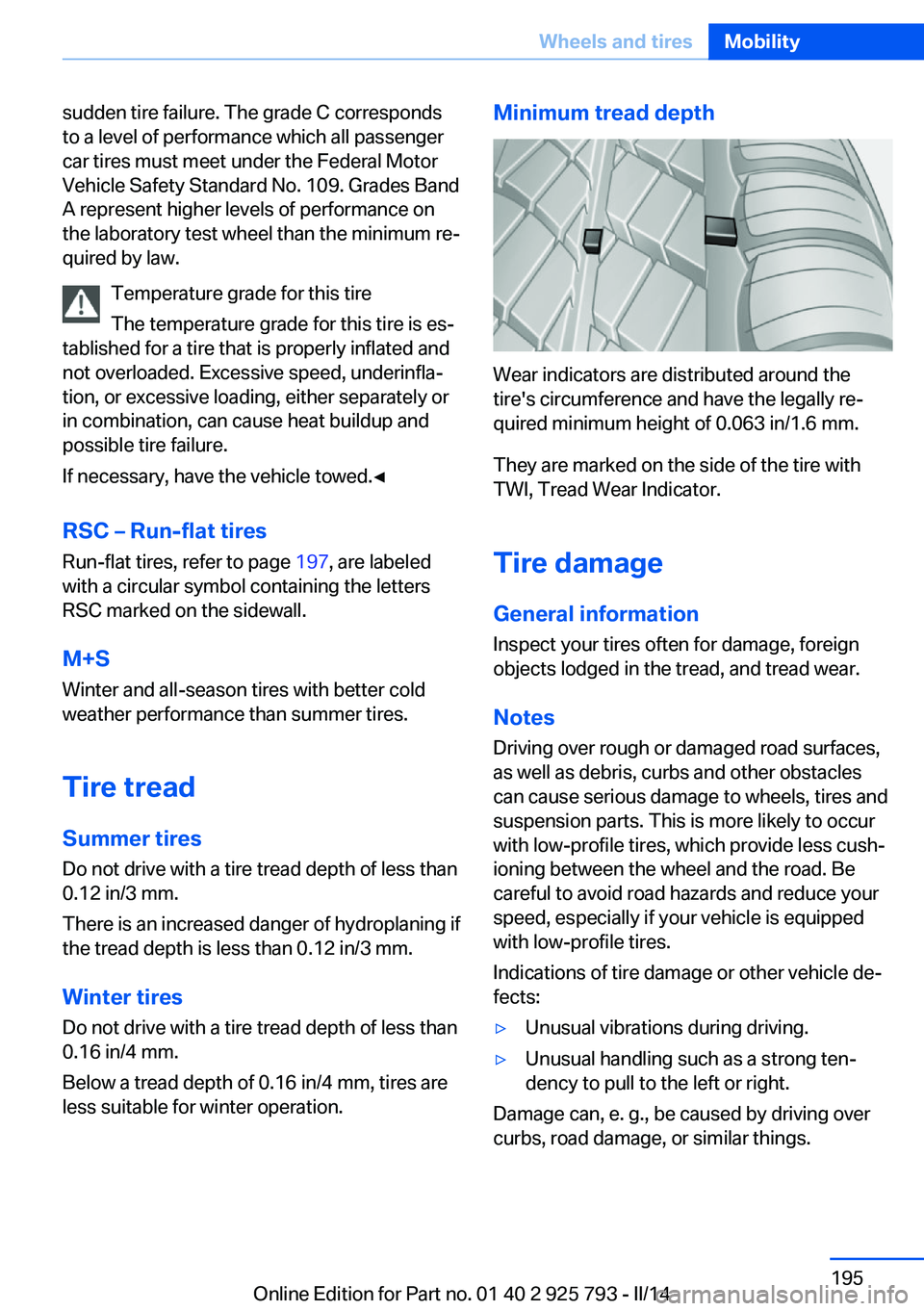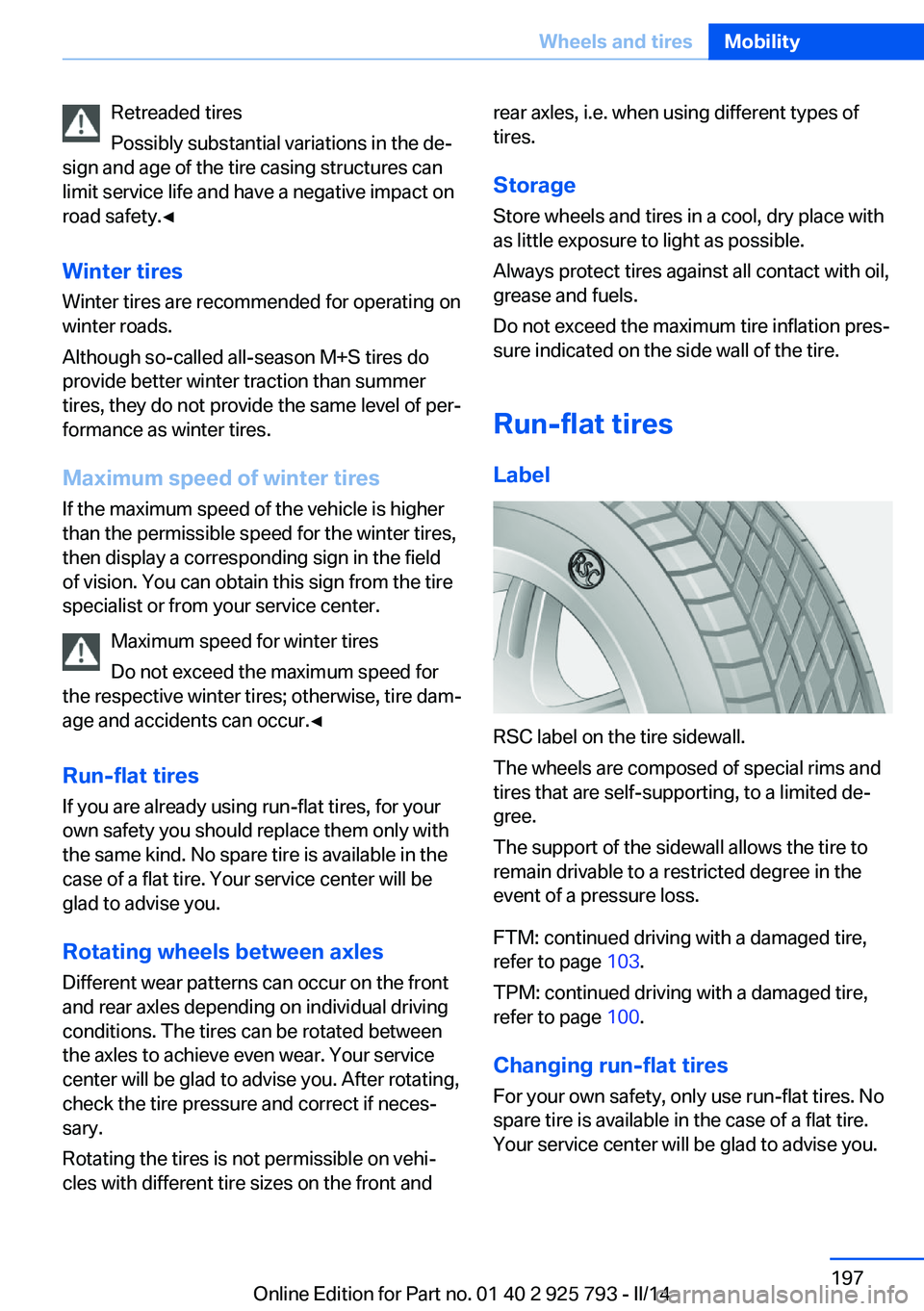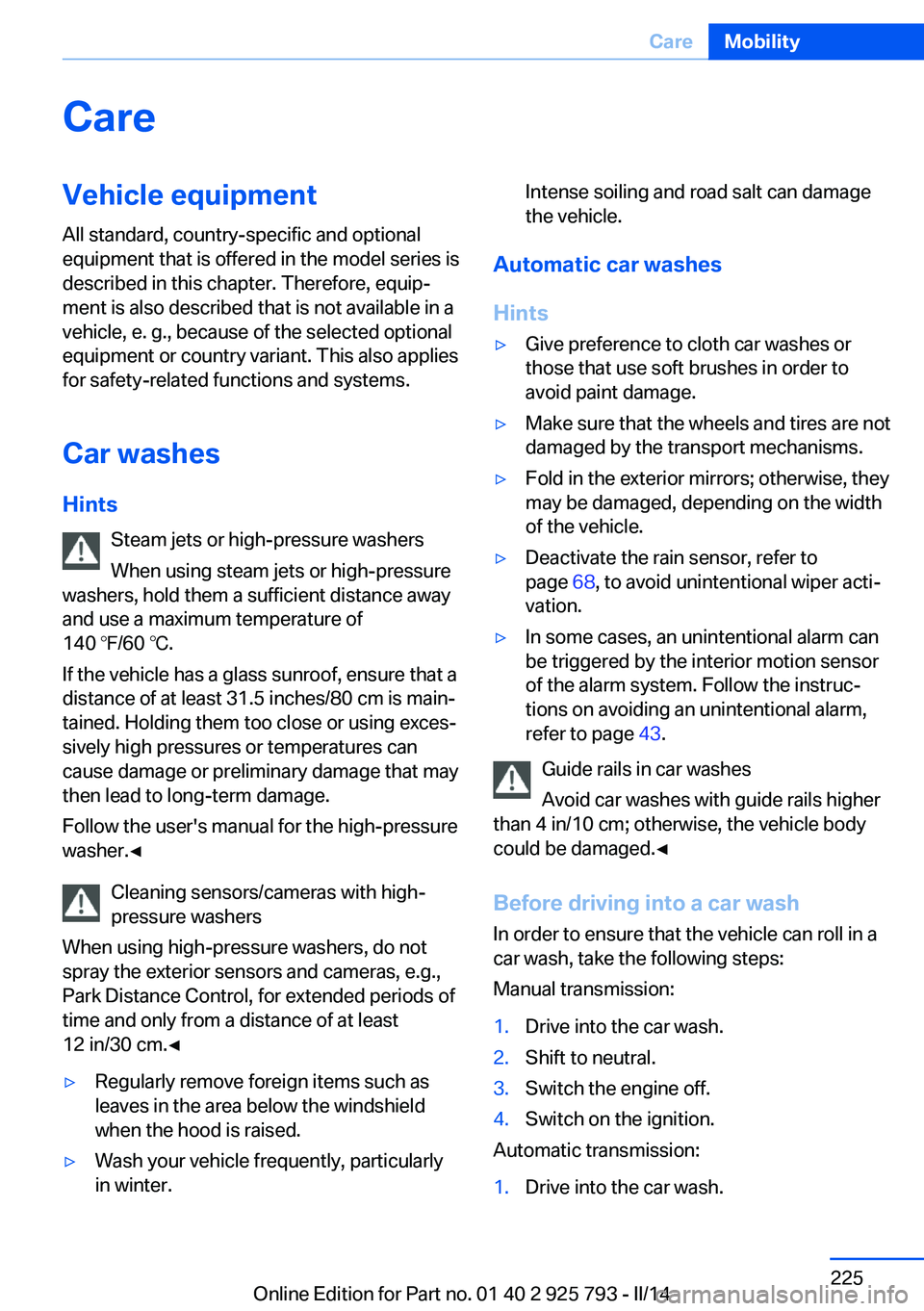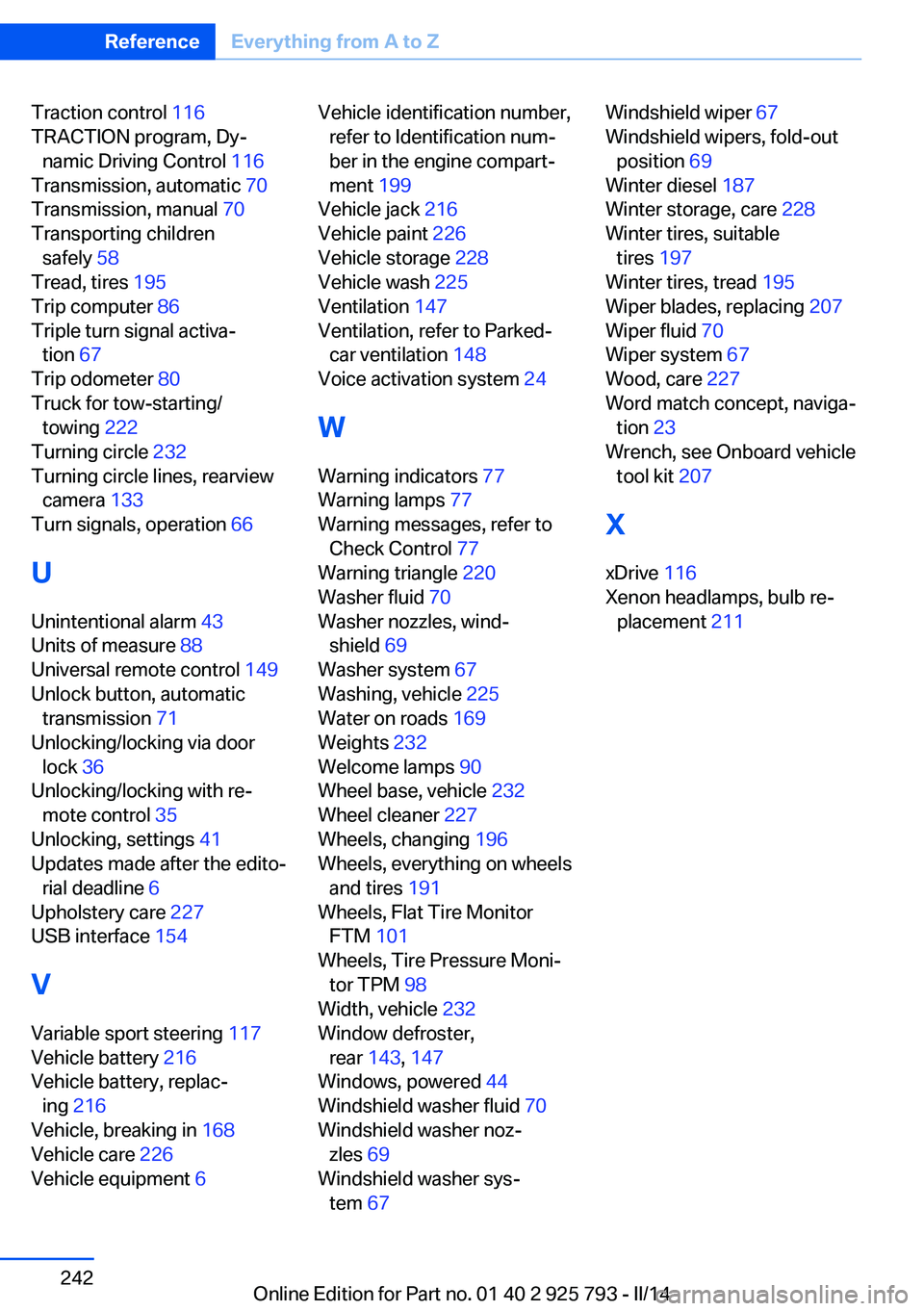2014 BMW 328D XDRIVE SPORTS WAGON winter tires
[x] Cancel search: winter tiresPage 195 of 244

sudden tire failure. The grade C corresponds
to a level of performance which all passenger
car tires must meet under the Federal Motor
Vehicle Safety Standard No. 109. Grades Band
A represent higher levels of performance on
the laboratory test wheel than the minimum re‐
quired by law.
Temperature grade for this tire
The temperature grade for this tire is es‐
tablished for a tire that is properly inflated and
not overloaded. Excessive speed, underinfla‐
tion, or excessive loading, either separately or
in combination, can cause heat buildup and
possible tire failure.
If necessary, have the vehicle towed.◀
RSC – Run-flat tires
Run-flat tires, refer to page 197, are labeled
with a circular symbol containing the letters
RSC marked on the sidewall.
M+S
Winter and all-season tires with better cold
weather performance than summer tires.
Tire treadSummer tires
Do not drive with a tire tread depth of less than
0.12 in/3 mm.
There is an increased danger of hydroplaning if
the tread depth is less than 0.12 in/3 mm.
Winter tires
Do not drive with a tire tread depth of less than
0.16 in/4 mm.
Below a tread depth of 0.16 in/4 mm, tires are
less suitable for winter operation.Minimum tread depth
Wear indicators are distributed around the
tire's circumference and have the legally re‐
quired minimum height of 0.063 in/1.6 mm.
They are marked on the side of the tire with
TWI, Tread Wear Indicator.
Tire damage
General information
Inspect your tires often for damage, foreign
objects lodged in the tread, and tread wear.
Notes
Driving over rough or damaged road surfaces,
as well as debris, curbs and other obstacles can cause serious damage to wheels, tires and
suspension parts. This is more likely to occur
with low-profile tires, which provide less cush‐
ioning between the wheel and the road. Be
careful to avoid road hazards and reduce your
speed, especially if your vehicle is equipped
with low-profile tires.
Indications of tire damage or other vehicle de‐
fects:
▷Unusual vibrations during driving.▷Unusual handling such as a strong ten‐
dency to pull to the left or right.
Damage can, e. g., be caused by driving over
curbs, road damage, or similar things.
Seite 195Wheels and tiresMobility195
Online Edition for Part no. 01 40 2 925 793 - II/14
Page 197 of 244

Retreaded tires
Possibly substantial variations in the de‐
sign and age of the tire casing structures can
limit service life and have a negative impact on
road safety.◀
Winter tires
Winter tires are recommended for operating on
winter roads.
Although so-called all-season M+S tires do
provide better winter traction than summer tires, they do not provide the same level of per‐
formance as winter tires.
Maximum speed of winter tires If the maximum speed of the vehicle is higher
than the permissible speed for the winter tires,
then display a corresponding sign in the field
of vision. You can obtain this sign from the tire
specialist or from your service center.
Maximum speed for winter tires
Do not exceed the maximum speed for
the respective winter tires; otherwise, tire dam‐
age and accidents can occur.◀
Run-flat tires If you are already using run-flat tires, for your
own safety you should replace them only with
the same kind. No spare tire is available in the
case of a flat tire. Your service center will be
glad to advise you.
Rotating wheels between axles Different wear patterns can occur on the front
and rear axles depending on individual driving
conditions. The tires can be rotated between
the axles to achieve even wear. Your service
center will be glad to advise you. After rotating,
check the tire pressure and correct if neces‐
sary.
Rotating the tires is not permissible on vehi‐
cles with different tire sizes on the front andrear axles, i.e. when using different types of
tires.
Storage
Store wheels and tires in a cool, dry place with
as little exposure to light as possible.
Always protect tires against all contact with oil,
grease and fuels.
Do not exceed the maximum tire inflation pres‐
sure indicated on the side wall of the tire.
Run-flat tires
Label
RSC label on the tire sidewall.
The wheels are composed of special rims and
tires that are self-supporting, to a limited de‐
gree.
The support of the sidewall allows the tire to
remain drivable to a restricted degree in the
event of a pressure loss.
FTM: continued driving with a damaged tire,
refer to page 103.
TPM: continued driving with a damaged tire,
refer to page 100.
Changing run-flat tires
For your own safety, only use run-flat tires. No
spare tire is available in the case of a flat tire.
Your service center will be glad to advise you.
Seite 197Wheels and tiresMobility197
Online Edition for Part no. 01 40 2 925 793 - II/14
Page 225 of 244

CareVehicle equipmentAll standard, country-specific and optional
equipment that is offered in the model series is
described in this chapter. Therefore, equip‐
ment is also described that is not available in a
vehicle, e. g., because of the selected optional
equipment or country variant. This also applies
for safety-related functions and systems.
Car washes Hints Steam jets or high-pressure washers
When using steam jets or high-pressure
washers, hold them a sufficient distance away and use a maximum temperature of
140 ℉/60 ℃.
If the vehicle has a glass sunroof, ensure that a distance of at least 31.5 inches/80 cm is main‐
tained. Holding them too close or using exces‐
sively high pressures or temperatures can
cause damage or preliminary damage that may
then lead to long-term damage.
Follow the user's manual for the high-pressure
washer.◀
Cleaning sensors/cameras with high-
pressure washers
When using high-pressure washers, do not
spray the exterior sensors and cameras, e.g., Park Distance Control, for extended periods of
time and only from a distance of at least
12 in/30 cm.◀▷Regularly remove foreign items such as
leaves in the area below the windshield
when the hood is raised.▷Wash your vehicle frequently, particularly
in winter.Intense soiling and road salt can damage
the vehicle.
Automatic car washes
Hints
▷Give preference to cloth car washes or
those that use soft brushes in order to
avoid paint damage.▷Make sure that the wheels and tires are not
damaged by the transport mechanisms.▷Fold in the exterior mirrors; otherwise, they
may be damaged, depending on the width
of the vehicle.▷Deactivate the rain sensor, refer to
page 68, to avoid unintentional wiper acti‐
vation.▷In some cases, an unintentional alarm can
be triggered by the interior motion sensor
of the alarm system. Follow the instruc‐
tions on avoiding an unintentional alarm,
refer to page 43.
Guide rails in car washes
Avoid car washes with guide rails higher
than 4 in/10 cm; otherwise, the vehicle body
could be damaged.◀
Before driving into a car wash In order to ensure that the vehicle can roll in a
car wash, take the following steps:
Manual transmission:
1.Drive into the car wash.2.Shift to neutral.3.Switch the engine off.4.Switch on the ignition.
Automatic transmission:
1.Drive into the car wash.Seite 225CareMobility225
Online Edition for Part no. 01 40 2 925 793 - II/14
Page 239 of 244

Maintenance system,BMW 205
Malfunction displays, refer to Check Control 77
Manual air distribu‐ tion 143, 147
Manual air flow 143, 147
Manual mode, transmis‐ sion 72
Manual operation, door lock 36
Manual operation, exterior mirrors 56
Manual operation, fuel filler flap 184
Manual operation, Park Dis‐ tance Control PDC 130
Manual operation, rearview camera 132
Manual operation, Side View 134
Manual operation, Top View 136
Manual transmission 70
Marking on approved tires 196
Marking, run-flat tires 197
Master key, refer to Remote control 32
Maximum cooling 146
Maximum speed, display 82
Maximum speed, winter tires 197
Measure, units of 88
Medical kit 220
Memory, seat, mirror 54
Menu, EfficientDynamics 177
Menu in instrument clus‐ ter 84
Menus, operating, iDrive 16
Menus, refer to iDrive operat‐ ing concept 18
Messages, refer to Check Control 77
Microfilter 144, 147
Minimum tread, tires 195 Mirror 55
Mirror memory 54
Mobile communication devi‐ ces in the vehicle 169
Modifications, technical, refer to Safety 7
Moisture in headlamp 208
Monitor, refer to Control Dis‐ play 16
Mounting of child restraint fix‐ ing systems 58
Multifunction steering wheel, buttons 12
N Navigation, see user's manual for Navigation, Entertain‐
ment and Communication
Neck restraints, front, refer to Head restraints 52
Neck restraints, rear, refer to Head restraints 53
Neutral cleaner, see wheel cleaner 227
New wheels and tires 196
No Passing Information 82
Nylon rope for tow-starting/ towing 223
O OBD Onboard Diagnosis 205
OBD, see OBD Onboard Di‐ agnosis 205
Obstacle marking, rearview camera 133
Octane rating, refer to Rec‐ ommended fuel grade 186
Odometer 80
Office, see user's manual for Navigation, Entertainment
and Communication
Oil 201
Oil, adding 202
Oil additives 202 Oil change 203
Oil change interval, service requirements 81
Oil filler neck 202
Oil types, alternative 203
Oil types, approved 203
Old batteries, disposal 217
Onboard monitor, refer to Control Display 16
Onboard vehicle tool kit 207
Opening/closing via door lock 36
Opening and closing 32
Opening and closing, without remote control 36
Opening and closing, with re‐ mote control 35
Opening the tailgate with no- touch activation 40
Operating concept, iDrive 16
Optional equipment, standard equipment 6
Outside air, refer to Auto‐ matic recirculated-air con‐
trol 146
Overheating of engine, refer to Coolant temperature 79
P Paint, vehicle 226
Panoramic glass sunroof 45
Parallel parking assistant 137
Park Distance Control PDC 129
Parked-car ventilation 148
Parked vehicle, condensa‐ tion 170
Parking aid, refer to PDC 129
Parking assistant 137
Parking brake 66
Parking lamps 90
Particulate filter 169
Partition net 157
Parts and accessories 7 Seite 239Everything from A to ZReference239
Online Edition for Part no. 01 40 2 925 793 - II/14
Page 242 of 244

Traction control 116
TRACTION program, Dy‐ namic Driving Control 116
Transmission, automatic 70
Transmission, manual 70
Transporting children safely 58
Tread, tires 195
Trip computer 86
Triple turn signal activa‐ tion 67
Trip odometer 80
Truck for tow-starting/ towing 222
Turning circle 232
Turning circle lines, rearview camera 133
Turn signals, operation 66
U Unintentional alarm 43
Units of measure 88
Universal remote control 149
Unlock button, automatic transmission 71
Unlocking/locking via door lock 36
Unlocking/locking with re‐ mote control 35
Unlocking, settings 41
Updates made after the edito‐ rial deadline 6
Upholstery care 227
USB interface 154
V Variable sport steering 117
Vehicle battery 216
Vehicle battery, replac‐ ing 216
Vehicle, breaking in 168
Vehicle care 226
Vehicle equipment 6 Vehicle identification number,
refer to Identification num‐
ber in the engine compart‐
ment 199
Vehicle jack 216
Vehicle paint 226
Vehicle storage 228
Vehicle wash 225
Ventilation 147
Ventilation, refer to Parked- car ventilation 148
Voice activation system 24
W Warning indicators 77
Warning lamps 77
Warning messages, refer to Check Control 77
Warning triangle 220
Washer fluid 70
Washer nozzles, wind‐ shield 69
Washer system 67
Washing, vehicle 225
Water on roads 169
Weights 232
Welcome lamps 90
Wheel base, vehicle 232
Wheel cleaner 227
Wheels, changing 196
Wheels, everything on wheels and tires 191
Wheels, Flat Tire Monitor FTM 101
Wheels, Tire Pressure Moni‐ tor TPM 98
Width, vehicle 232
Window defroster, rear 143, 147
Windows, powered 44
Windshield washer fluid 70
Windshield washer noz‐ zles 69
Windshield washer sys‐ tem 67 Windshield wiper 67
Windshield wipers, fold-out position 69
Winter diesel 187
Winter storage, care 228
Winter tires, suitable tires 197
Winter tires, tread 195
Wiper blades, replacing 207
Wiper fluid 70
Wiper system 67
Wood, care 227
Word match concept, naviga‐ tion 23
Wrench, see Onboard vehicle tool kit 207
X
xDrive 116
Xenon headlamps, bulb re‐ placement 211 Seite 242ReferenceEverything from A to Z242
Online Edition for Part no. 01 40 2 925 793 - II/14